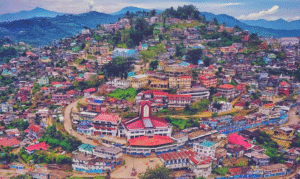About 53km from Meghalaya’s capital Shillong, the lesser-known land of Khongtong lies. It is present in the scenic Khasi Hills of the state. Known for its forested lands and a lexicon unique to the village, it hums over 650 tunes instead of names to communicate with one another in the hills.
Geography
The Monsoon Mountains of Meghalaya have more to offer. In the east Khasi hills, amidst the scenery, lies the singing village which is located at a height of 1530 meters. This height has separated the community from the hustle of city life.
The locals prefer to live in the serene clean air. This place is surrounded by clear lakes that reflect the green mountains on its water. The Singing Village, with its scenic grace, becomes a captivating land of unspoiled nature.
Population
The village of Khongtong is sparsely populated. The estimated population is said to be somewhat around 500-600. The official language of the Khangtong inhabitants is Khasi as the inhabitants living here belong to the Khasi tribe. While that might be their official language, their restricted use of worded vocabulary is what sets them apart from the rest.
The land of sounds
Through geographical isolation and cultural solidarity, the locals of Khongtong have maintained a lineage of traditions from the past. The tradition that sets itself apart from the world is known as ‘jingrwaiiawbei’ which literally means a song dedicated to your grandmother. It has been woven into the very identity of this place contributing to its uniqueness.
These villages of East Khasi hills speak a lyrical tale of a community, whose identity is mixed with the very tunes of each living in the land. Each individual in the community has a unique tone designated to them at birth which dies out with their demise.
The dead are often remembered by their tones as well. The tune is composed by the birth-giving mother for their newborn. It is customarily inspired by their beloved song to showcase affection for their child.
The Whistling Land
The Whistling Land has been declared as the best tourism village by the Ministry of Tourism for the World Tourism Organization of the United Nations. This hidden village has been recently discovered. The inhabitants themselves are much of a mystery themselves.

Keeping themselves isolated from the mainstream, they have sustained a safe haven for their terrain and people. However, the locals are very sweet and welcoming. They lead a slow life amidst nature and believe in a need-based lifestyle.
Lifestyle of Khongtong
The villagers live in Khasi Huts which reflects the Khasi way of living in its most authentic way. It is made up of locally found materials like dried leaves and bamboo. The huts are built above the grounds to prevent animals and snakes from entering them. This protects them at night. The huts are built in such a way that supports indoor ways of cooking, preserving, and keeping warm even on cold winter nights. It has ample ventilation for the smoke to escape. This village mirrors and true nature of Khasi culture.
Honey Cultivation
Honey is predominantly found in Khongtong. The traditional practice of collecting honey is still being followed. It is a part of their occupation as well. Honey is collected in small wood containers that the villagers set up lower near their huts for bees to make hives. After the honeycomb is formed, the locals harvest it. Lately, they have been using tin containers for its long sustenance.
Religion
The people of Khongtong practice a unique religious tradition known as Seng Khasi. This belief system is deeply attached to their way of life. It shapes their practices, values, and identity. However, due to their limited population and remoteness, their story remains largely untold.
Spirituality
Seng Khasi translates into the “religion of the hills.” It is an animistic belief system that has some roots and elements of Hinduism. The Khongtong people believe in the spirits of nature, believing they reside in trees, rivers, and mountains. These spirits, known as Bei Be, are appeased through rituals and offerings to ensure harmony and well-being.
Additionally, they acknowledge deities from the Hindus, incorporating them into their own unique spiritual framework. This unique blend reflects the historical influences and cultural exchanges that shaped the Khongtong community.
Practices and Rituals
The core of Seng Khasi lies in its rituals and practices. The ‘Lyngdoh,’ a spiritual leader, plays a vital role in conducting ceremonies and communicating with the spirit world. Animal sacrifices, chants, and prayers are integral parts of seeking blessings for good health, bountiful harvests, and protection from misfortune. Festivals like ‘Phaphan’ and ‘Rongker’ mark significant occasions, bringing the community together in celebration and reaffirming their shared beliefs.
Culture and Traditions
The Khongtong people are renowned for their artistic skills and craftsmanship. Blacksmithing, weaving, and basketry are some of their traditional occupations, passed down through generations. They are also skilled in metalwork. Locally made handloom products are not only utilitarian but also have some cultural significance.
Other than that, agriculture remains a central part of their livelihood, with families working their lands to cultivate rice, vegetables, and other crops to sustain themselves through geographical isolation.
Balancing Tradition and Modernity
The Khongtong people face challenges in the modern world. With increasing exposure to the outside world, their traditional way of life is gradually changing. Younger generations are migrating to urban areas for education and employment opportunities. While this brings economic benefits, it also raises concerns about cultural preservation. The community strives to find a balance between embracing progress and upholding their cherished heritage.
Conclusion
The isolation of Khongtong plays a big role in keeping their culture and rituals alive. The peaceful way of life has made them close to nature. They have chosen a very quiet way of life amidst nature. It is influenced by the Seng Khasi religion and culture of the Khongtong people. It offers a glimpse into a world where reverence for nature and tradition reign supreme.
In a changing world with its own set of complexities, this village has maintained its channel of communication through tunes. This shows the passion of Whistling Village to uphold their traditions and ancestors.
Unraveling a billion untold stories, one chapter at a time, Humans of Northeast takes you on a discovery through vibrant Northeast India – a land rich in people, places, and culture. Ready to immerse yourself in more such stories?
Visit our page HONEI to read more about narratives that inspire and uplift.






